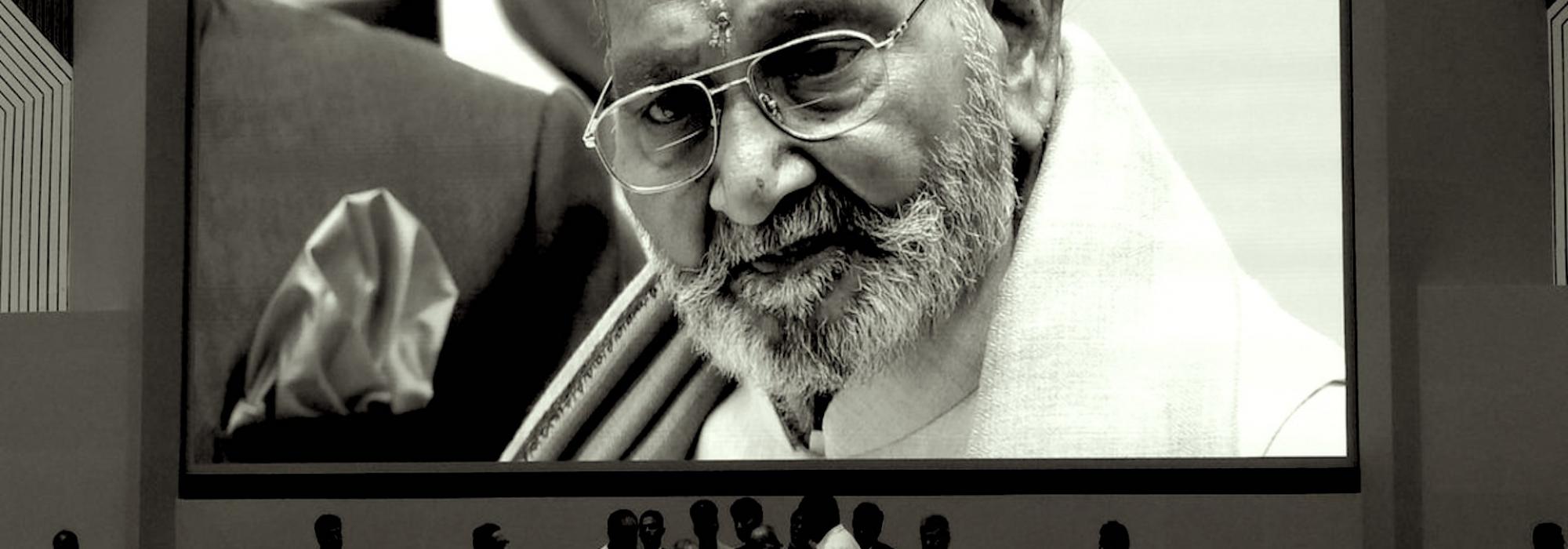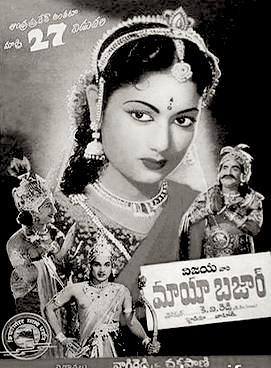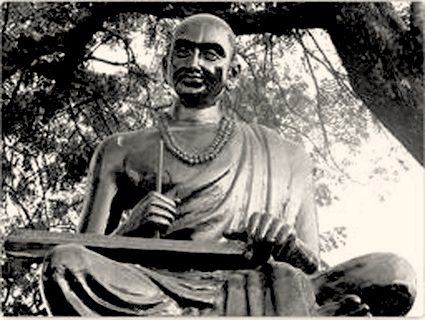A reasonable place to assess the overall contribution of K Viswanath to Indian cinema is the 1976 musical and social blockbuster, Siri Siri Muvva. That film in a way marks a clean break and is the line that clearly demarcates Viswanath’s cinematic oeuvre as Sankarabharanam and post Sankarabharanam.
The period also plays a significant role in this assessment.
Past Masters
K Viswanath’s predecessors like B N Reddy, K V Reddy, C. Pullaiah, K. Kameswara Rao and others made films for an audience that intuitively connected with their mythologicals and epics. That was how they could seamlessly integrate stage elements like padyams, bombastic and lengthy dialogues, and similar devices in a dramatic fashion. These directors and writers heralded the dawn of Telugu cinema in a way, gave it shape and direction and blazed a glorious trail up to the mid-1960s. A measure of the kind of solid foundation that they laid and the influence that they continue to exert on contemporary Telugu cinema can be discerned through two important nuggets.
For instance, S S Rajamouli and Trivikram Srinivas the filmmakers currently in much demand, have on numerous occasions paid rich tributes to these movies both in nostalgic terms and have called for a “return” to that era. Rajamouli himself has made a rather vulgar attempt in his Yamadonga. But the deeper reason is how the dialogue bits and song lyrics have become names of films that followed these mythologicals and epics, and have also become memes in popular Telugu culture. Maya Bazaar holds the record in this respect.
So enduring is the impact of these films that it wasn’t uncommon even in the late 1970s for the audience to take the characters of Sri Krishna, Sri Rama, Lava, Kusha, Markandeya, Prahlada etc as real people. Not just real people, but there was a sense of ownership of these onscreen characters by the audience. This audience also had a certain trait of heaving a collective sigh of joy when Hiranyakashyipu was finally torn apart by Narasimha and the boy Prahlada’s devotion triumphed. There is, undeniably a sense of simple, touching beauty to this approach of watching such cinema. It was precisely this audience profile that catapulted N T Rama Rao to Chief Ministership.
The era of B N Reddy, K V Reddy, et al was over by the mid-1960s, and by the time K Viswanath made Sankarabharanam, the profile of filmmakers, actors, writers, and the audience had vastly changed, which in turn was the reflection of a changing India. In other words, Viswanath didn’t have the luxury of his predecessors.
Building on Past Masters
Instead, Viswanath built his cinema on the readily available, free inheritance of the selfsame predecessors. What they had accomplished by directly drawing from our epics and mythology, Viswanath matched by using them as subtexts, and akin to salt in a meal, delivered the same wholesome, elevated aesthetic experience. One is reminded of DVG’s insight in this context:
Alaripu means…a flower blossoming. The mind of the audience must blossom like how a flower does. After a Padam [musical verse] is sung and acted out, the artist’s mind too must blossom; so does the mind of those who listen and watch it.
After this…I praised the [Jayadeva] ashTapadi, “yAhi mAdhava.” Nagarathnamma held on to that portion and performed the Abhinaya [technical term in classical dance meaning any theatrical action, expressive of some sentiment, passion etc, such as a look, gesture, posture etc.] of the ashTapadi. It became clear to me only then that so many emotional nuances lay hidden in that tiny word, “yAhi.” Just like how a Mahakavi is a new creator, a master Abhinaya exponent likewise becomes a creator. Abhinaya too, is a kind of commentary, an exposition [Bhashya].
Which is why it can be reasonably said that K Viswanath’s cinema doesn’t fit into the well-known genres of Pauranikas (epics, mythology) or Sanghikas (social drama) and forms an independent, K Viswanath School. In fact, nobody in Indian cinema has thought of even touching the subject that Viswanath not only touched but turned to gold: of depicting classical life and its various facets within the framework of a contemporary story in the realm of commercial cinema.
This accomplishment becomes the more remarkable when we consider the total absence of Western elements in his films. The only Western element is the medium and technology of filmmaking and cinematic directorial craft and techniques. We can turn again to another of DVG’s memorable insights more than fifty years ago. Noting the proliferation of “newer and newer works of art into India” from the West, and whether they were capable of delivering true art (which he defines as the experience of beauty), he avers:
Perhaps I’ve become blind, my vision constricted by the confines of tradition with which I’m enraptured. To those who regard Jakkannachaari, Thyagayya, Valmiki as Gurus…such a person doesn’t find beauty in these [Western] artworks…does it mean others can’t find beauty in them? …. There’s a fundamental principle operating behind propriety in bodily beauty and proportion. Accordingly, the mind of the public must not become profligate by the sight of beauty or grandeur. This sight must generate happiness and not rage or provocation—this is the operative principle. A sense of shame acts as an instrument for this…it is the armour of art…in this manner, the job of an art creator is a responsible one. Just as he requires freedom, he also requires boundaries. [Bengaluru Nagarathnamma: Jnapaka Chitrashaale: DV Gundappa]
Almost without exception, K Viswanath’s cinematic corpus reflects these Gundappaesque attributes. The subtle sensuality in the picturization of the pleasant, romantic number, Mounamelanoyi, or the confrontational scene between S P Sailaja and Jayaprada in Sagara Sangamam are excellent samples of maintaining restraint in artistic creations. Or the fabled scene and dialogue in Sankarabharanam where Viswanath, through Sankara Sastry’s character, pays obeisance to Mysore Vasudevacharya. Words fall short in praising Jandhyala’s writing when he uses the analogy of a baby’s cry to sketch the concepts of bhava and rasa.
The Viswanath School of Cinema
Another striking distinction in K Viswanath’s classics is the total absence of villains: Swayam Krushi, Apadbandhavudu are stray exceptions because, well, they have Chiranjeevi in them. Enough said.
Actually, a well-lived life will contain no villains; hostile circumstances are the only villains. It’s equally the sign of a well-lived life which overcomes these circumstances. Given this, only great artists can create and handle a work of art where there are no negative characters. Which poses a bigger challenge: in this case, how does one bring conflict in drama? The answer remains the same: only through circumstances.
This is perhaps why a feeling of Nirveda, or a sense of profound dejection fills us after watching these classics. It is a dejection that doesn’t lead to despondency. It is a dejection that doesn’t culminate in cynicism but steers us towards balance and poise.
That said, some drawbacks in Viswanath’s films include a tendency to indulge in a dash of self-pity and a subtle glorification of suffering as a redeeming feature. This tendency is rather marked depending on the profile and “star” value of the leading actors. In Sagara Sangamam for instance, Kamal Haasan’s character at times tends to lapse into the, “oh, who will benefit if I live and who will lose if I die?” mode. In Apadbandhavudu, the scene where Jandhyala honours Chiranjeevi by touching his feet and worshipping him is overdone. Or Sumalatha’s character as the heroically suffering and wronged wife in Shruti Layalu, could’ve been underplayed or sketched differently.
From another angle, K Viswanath’s contribution becomes clearer by comparison when we examine the period of transition: that is, the period from 1965 to the early 1980s.
While V Shantaram had earlier paved the way by taking classicism and art forms as the central theme, his movies lacked emotional scale and depth and tried to glorify certain actors and placed inordinate emphasis on costumes, sets, etc. Of his deep devotion to our classicism, culture, art forms and festivals, there is no doubt. His handling and treatment of these elements leaves much to be desired.
We can also consider the iconic Kannada filmmaker, Puttanna Kanagal who made movies primarily based on novels. Apart from Upasane, where classical music is the central theme, in his other movies, he hasn’t touched classical subjects with the same subtlety, intensity or depth as Viswanath. However, he has artistically infused these classical elements in say Ranganayaki, which shows both the glory and downfall of traditional drama. Equally, his treatment of strong female characters derives from the traditional Indian conception of a woman. Even when they rebel or fight back against various injustices, they remain rooted in the Indian value of feminity.
In the annals of Tamil cinema, we can cite the talented K Balachander whose filmmaking can be described as sensitive and emotionally intelligent. Classicism was nearly non-existent in his cinema because he primarily focused on social issues coloured with a tinge of Leftism. Yet, his movies remained largely faithful to Indian values and ethos. Like Puttanna, he created strong female characters anchored in traditional values. His award-winning musical, Sindhubhairavi revolves more around the central character of the classical musician than on classical music itself. Such limitations have taken the pivot away from exploring art and the aesthetics of art in Balachander’s films.
Where K Viswanath differs and departs from these moviemakers is in creating elevated and emotionally intelligent cinema, which also has an understated, unassuming quality to it. This is no mean feat to attempt and to succeed in commercial cinema. And so, instead of making a biopic on say, Potana Mahakavi, he takes a renowned verse from Potana and conveys a range of emotions and values.
bAla rasAla sAla nava pallava kOmala kAvya kanyakan
kUlala kicchi yappadupu kUdu bhujinchuta kante satkavul
hAlikulaina nEmi gahanAntara sImala kandamUla kau-
ddalikulaina nEmi nija dAra sutOdara pOshanArthamai.
When Jandhyala recites this verse in Apadbandhavudu as a rebuke to the villainous Satyanarayana, Viswanath invokes within us the history and courage of Potana who defied the arrogant king of Warangal way back in the 15th Century.
Answering Criticism through Art
And through such devices, K Viswanath has also answered his critics who routinely mocked his movies as “Brahminical,” “regressive,” and so on. Instead of refuting them with theory, speeches, media statements, etc Viswanath refuted them through art. In this fashion, he has both followed the path of Rasa and has rendered a commendable service by reassuring us of the importance and centrality of Rasa to art and its experience.
Put another way, in the realm of cinema, K Viswanath has indeed done the same thing that Padma Subramhanyam has done in classical dance, M Balamuralikrishna in classical music, and S L Bhyrappa in literature. Which sounds exaggerated but isn’t.
Indian classical art is essentially a solo work. One is reminded of the masterly poem, Thought Fox by Ted Huges in this connection. But in a mass medium like cinema which has borderless appeal and exposure, the first and greatest challenge is to find likeminded producers and supporting crew. Not only did Viswanath find, convince, and assemble such a team, his greater triumph lies in bringing this soloist art on to this medium effectively, artistically, memorably. Just as S L Bhyrappa has given about seven or eight classics in literature, K Viswanath too, has given us an equal number of such classic films. These films indeed, are the true definitions of what is known as an “art” film, a term typically used in a leftist-elitist, high-brow tenor.
But how many of these “art” films have become commercial successes? Like the novels of say U R Ananthamurthy, how many of these movies drew mass appeal when they were released? Apart from a small clique of privileged film critics, it appears that the masses are intellectually deficient to understand the “hidden” meanings and interpretations they contain. In fact, one defining trait of these “art” films is the manner in which their makers take technique, technicality and craft to impossible levels of obscurity. That may well be fine and innovative but they abjectly fail in delivering Rasa.
Then there were the directors of “bridge” films like Hrishikesh Mukherjee who made fine movies and explored some aspects of Indian culture. But they didn’t delve into the finer and deeper aspects of this culture. Moreover, they were period-specific: had Chupke Chupke or Abhiman been made today, first, they either wouldn't find a producer or they would be commercially disastrous. Contrast that with a Sankarabharanam, which even after 37 years is still being discussed and watched, and its scenes and dialogues have become memes in popular imagination. Or Swarnakamalam, which had a dedicated TV show upon completing 25 years.
And like S L Bhyrappa’s novels, K Viswanath’s movies have universal appeal cutting through language, age, gender, and geography. And like S L Bhyrappa, Viswanath too stuck to his roots and devoted his art to exploring them, and showcasing their greatness with conviction, creativity and made no noise in the process. Like a lifelong dIksha, a sacred vow. And like S L Bhyrappa, Viswanath’s art is magnanimous.
Talking about his themes, K Viswanath said that he took merely a bucketful of water from the Ganga of Sanatana Dharma. In an interview, S P Balasubramhanyam quotes Viswanath as saying this about Sagara Sangamam, when the filmmaker himself watched it again after many years: “enta manchi cinema teesyaanu ra! (what a good movie I’ve made!)”
While K Viswanath’s contemporaries in filmmaking drifted away to politics, business and other fields, he remained true to both his art and his medium. It is truly a remarkable and noble journey.
Or to borrow a line from a lyric from his own Sankarabharanam, K Viswanath’s cinema, like Sankara Sastry’s music is, “Rasikulakanuraga mai rasagangalo tAna mai.”
Postscript: There are no words in the lexicon to express my indebtedness to Shatavadhani Dr. Ganesh's expositions and insights and above all, his penance-like patience in the making of this series. It would be accurate to say that he is the soul of this series. He gave this as a Siddham Annam, readymade food, which I consumed. EndarO mahAnubhAvulu okkarike vandanamulu.
CONCLUDED

















































